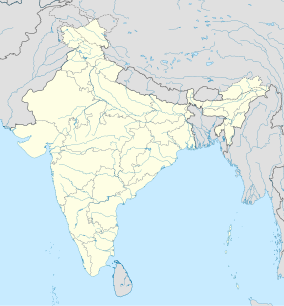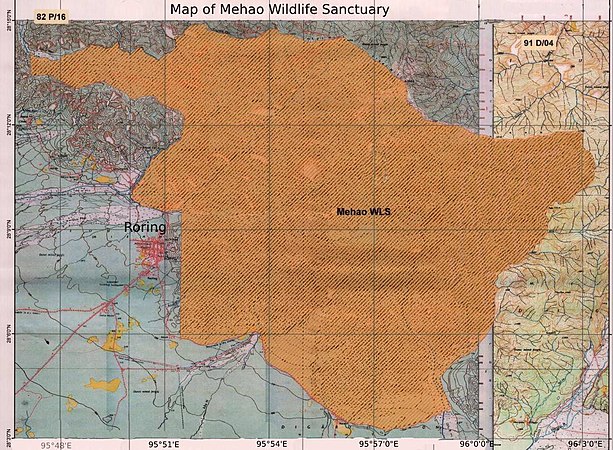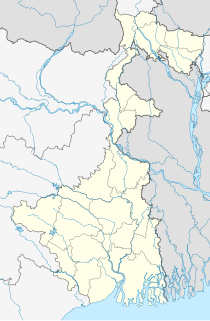
Mahananda Wildlife Sanctuary is located on the foothills of the Himalayas, between the Teesta and Mahananda rivers. Situated in the Darjeeling district of West Bengal, India; it comes under Darjeeling Wildlife division and can be reached from Siliguri in 30 minutes. Sukna, the gateway to the sanctuary, is only 13 km from Siliguri and 28 km from Bagdogra airport. The sanctuary sprawls over 159 km2 of reserve forest and was started as a game sanctuary in 1955. In 1959, it got the status of a sanctuary mainly to protect the Indian bison and royal Bengal tiger, which were facing the threat of extinction.

The Nilgiri Biosphere Reserve is an International Biosphere Reserve in the Western Ghats and Nilgiri Hills ranges of South India. The Nilgiri Sub-Cluster is a part of the Western Ghats, which was declared a World Heritage Site by UNESCO in 2012. It is the largest protected forest area in India, spreading across Tamil Nadu, Karnataka and Kerala. It includes the Aralam, Mudumalai, Mukurthi, Nagarhole, Bandipur and Silent Valley national parks, as well as the Wayanad, Karimpuzha, and Sathyamangalam wildlife sanctuaries.

The Mudumalai National Park and Wildlife Sanctuary also a declared tiger reserve, lies in the northwestern side of the Nilgiri Hills, in Nilgiri District, about 150 kilometres (93 mi) north-west of Coimbatore city in Tamil Nadu, India. It shares its boundaries with the states of Karnataka and Kerala. The sanctuary is divided into five ranges – Masinagudi, Thepakadu, Mudumalai, Kargudi and Nellakota.

Dibru-Saikhowa National Park is a national park in Assam, India, located in Dibrugarh and Tinsukia districts. It was designated a Biosphere Reserve in July 1997 with an area of 765 km2 (295 sq mi), including a core area of 340 km2 (130 sq mi) and a buffer zone of 425 km2 (164 sq mi).

Sri Venkateswara National Park is a national park and biosphere reserve in Andhra Pradesh, India. The total area of the park is 353 km2. The park is known for its many waterfalls, including the Talakona, Gundalakona and Gunjana. As the government of India declared the Seshachalam Hills as one of the biosphere reserves of India in 2010, this national park becomes the part of it.

The Brahmaputra Valley semi-evergreen forests is a tropical moist broadleaf forest ecoregion of Northeastern India and southern Bhutan.

Manas National Park or Manas Wildlife Sanctuary (Pron:ˈmʌnəs) is a national park, UNESCO Natural World Heritage site, a Project Tiger reserve, an elephant reserve and a biosphere reserve in Assam, India. Located in the Himalayan foothills, it is contiguous with the Royal Manas National Park in Bhutan. The park is known for its rare and endangered endemic wildlife such as the Assam roofed turtle, hispid hare, golden langur and pygmy hog. Manas is famous for its population of the wild water buffalo.
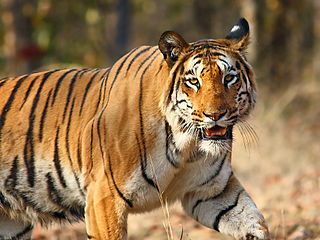
India is home to a large variety of wildlife. It is a biodiversity hotspot with its various ecosystems ranging from the Himalayas in the north to the evergreen rain forests in the south, the desert sands of the west to the marshy mangroves of the east. India, lying within the Indomalayan realm, is home to about 7.6% of mammal, 14.7% of amphibian, 6% of bird, 6.2% of reptilian, and 6.0% of flowering plant species. India's forest lands nurture about 500 species of mammals and 2000+ bird species.

The state of Karnataka in South India has a rich diversity of flora and fauna. It has a recorded forest area of 38720 km2 which constitutes 12.3467719% of the total geographical area of the state. These forests support 25% of the elephant population and 20% of the tiger population of India. Many regions of Karnataka are still unexplored and new species of flora and fauna are still found. The Western Ghats mountains in the western region of Karnataka are a biodiversity hotspot. Two sub-clusters of the Western Ghats, Talacauvery and Kudremukh in Karnataka, are in a tentative list of sites that could be designated as World Heritage Sites by UNESCO. The Bandipur and Nagarahole national parks which fall outside these subclusters were included in the Nilgiri biosphere reserve in 1986, a UNESCO designation. Biligiriranga Hills in Karnataka is a place where Eastern Ghats meets Western Ghats. The state bird and state animal of Karnataka are Indian roller and the Indian elephant respectively. The state tree and state flower are sandalwood and lotus respectively. Karnataka is home to 406+ tigers.

Madhya Pradesh, often called the Heart of India, is a state in central India. Its capital is Bhopal. Madhya Pradesh was originally the largest state in India until November 1, 2000 when the state of Chhattisgarh was carved out. It borders the states Uttar Pradesh, Chhattisgarh, Maharashtra, Gujarat and Rajasthan.
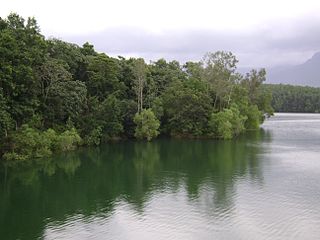
The Peppara Wildlife Sanctuary is a wildlife sanctuary in Thiruvananthapuram district of Kerala, India. It consists of the catchment area of the Karamana River, which originates from Chemmunjimottai, the tallest hill within the sanctuary. The sanctuary is named after the Peppara Dam, commissioned in 1983 to augment the drinking water supply to Thiruvananthapuram city and suburban areas. Considering the ecological significance of the area, it was declared a sanctuary in 1983. The terrain is undulating with elevation ranging from 100 m to 1717 m. The area of the sanctuary is 75 km2 with tropical moist evergreen forests and myristica swamps. It is part of the Agasthyamala Biosphere Reserve. Peppara Wildlife Sanctuary is 44 kilometres (27 mi) by car from the nearest railway station, at Thiruvananthapuram, and 49 kilometres (30 mi) from the Thiruvananthapuram airport.

Bhimbandh Wildlife Sanctuary is a wildlife sanctuary in Bihar in the south-west of Munger district near Jamui district.

The Western Himalayan broadleaf forests is a temperate broadleaf and mixed forest ecoregion which is found in the middle elevations of the western Himalayas, including parts of Nepal, India, and Pakistan.

Dehing Patkai National Park is located in the Dibrugarh and Tinsukia districts of Assam and covers an area of 231.65 km2 (89.44 sq mi) rainforest. It was declared a wildlife sanctuary on 13 June 2004. On 13 December 2020 Government of Assam upgraded it into a national park. On 9 June 2021 Forest Department of Assam officially notified it as a national park. It is located in the Dehing patkai landscape which is a dipterocarp-dominated lowland rainforest. The rainforest stretches for more than 575 km2 (222 sq mi) in the districts of Dibrugarh, Tinsukia and Charaideo. The forest further spreads over in the Tirap and Changlang districts of Arunachal Pradesh. The Dehing Patkai forms the largest stretch of lowland rainforests in India. The Dehing Patkai Wildlife Sanctuary was declared as Dehing-Patkai Elephant Reserve under Project Elephant.

Papikonda National Park is located near Rajamahendravaram in the Papi Hills in East Godavari and West Godavari districts of Andhra Pradesh, and covers an area of 1,012.86 km2 (391.07 sq mi). It is an Important Bird and Biodiversity Area and home to some endangered species of flora and fauna. No part of Papikonda remains outside East and West Godavari districts after 2014 and after the construction of Polavaram Dam.

Lengteng Wildlife Sanctuary is a protected area in Saitual district in eastern Mizoram, northeast India. It is an alpine forest and contains the second highest peak in Mizoram. It is specially a conservation interest on rare species of birds. It was declared a protected area in 1999, and a national wildlife sanctuary by the Indian Ministry of Environment and Forests on 31 May 2001.
Veerangana Durgawati Wildlife Sanctuary is a wildlife sanctuary in Damoh district of Madhya Pradesh, India. Named after Rani Durgavati, a queen of the Gondi people, and covering an area of only 24 sq km, the sanctuary was notified by the Government of Madhya Pradesh in 1996.
Dehing Patkai Landscape, located in the Upper Assam, stretches for over roughly 600 square kilometres and comprises three large blocks of forests and several forest fragments. The forest is classified as a lowland Tropical Wet Evergreen Forest (Dipterocarpus-Mesua). It falls under Indo-Burma Biodiversity Hotspot. Due to its biodiversity and significance for elephant habitat, parts of the landscape are recognised as Dehing Patkai Elephant Reserve and 111 km2 is protected as the Dehing Patkai Wildlife Sanctuary since 2004.

The Itanagar wildlife sanctuary was declared with an aim to conserve the biodiversity around the Itanagar sanctuary. The reserve forest around Itanagar became part of the sanctuary. The sanctuary has geographical boundary limits as River Pam to the east, Pachin in the south, Neorochi on the north-East and Chingke stream in the north. The terrain is mostly hilly. Since the sanctuary is close to the city, it plays an important role in environmental education.

